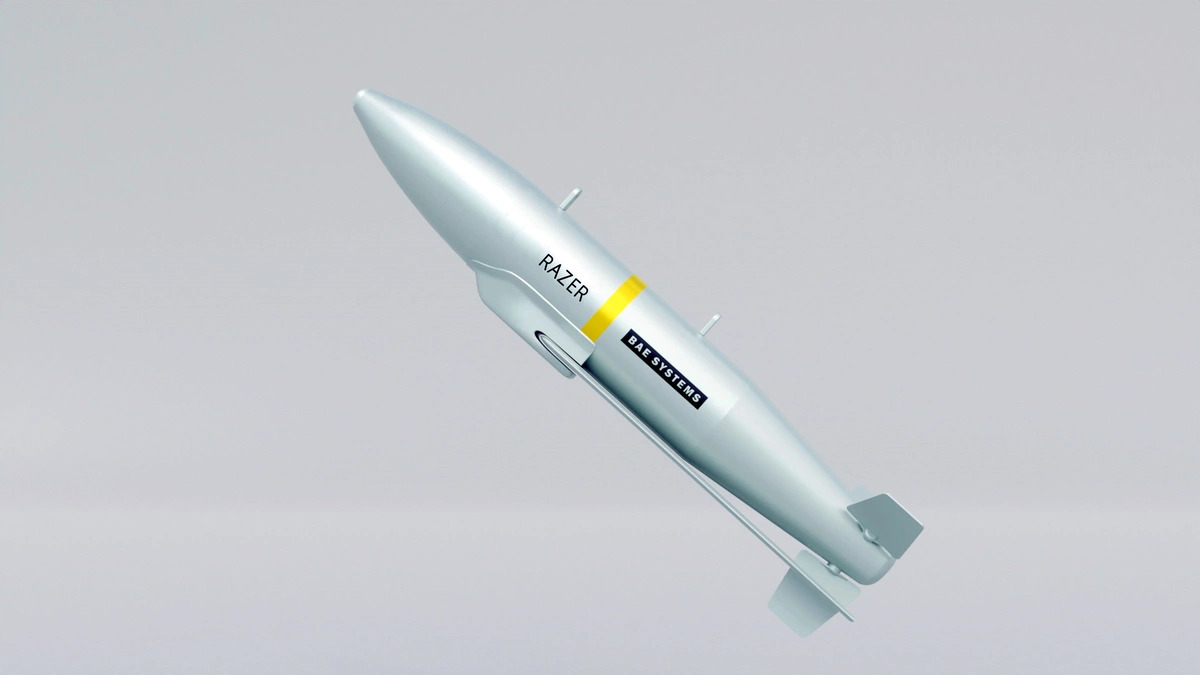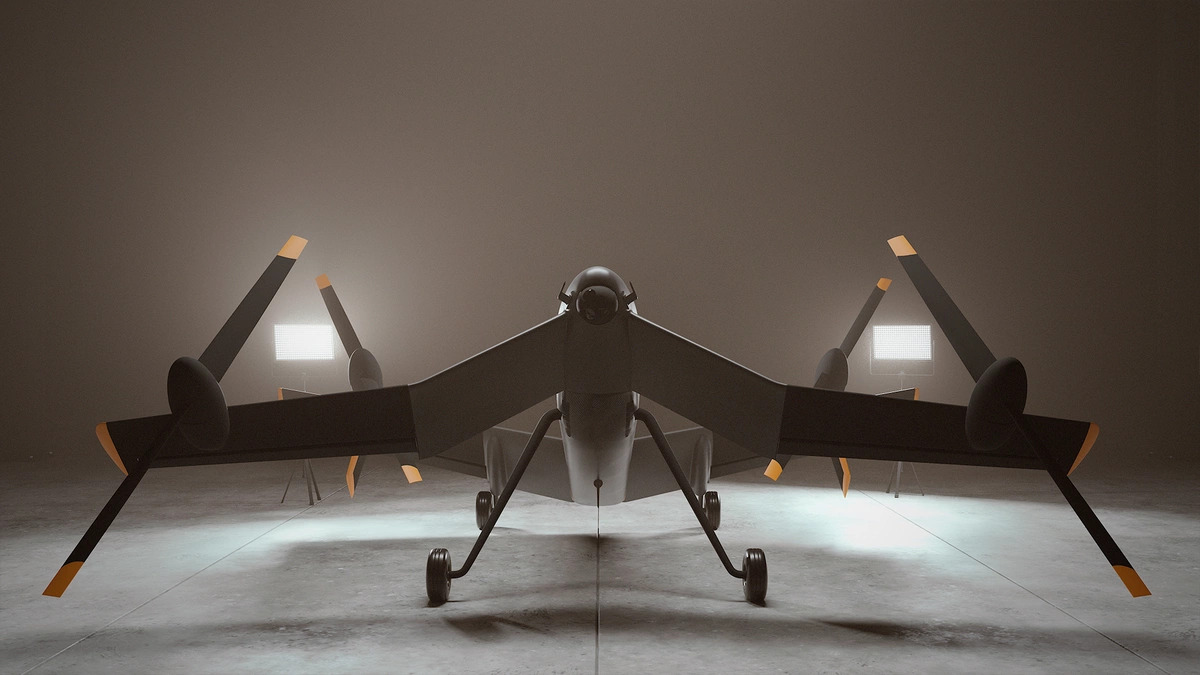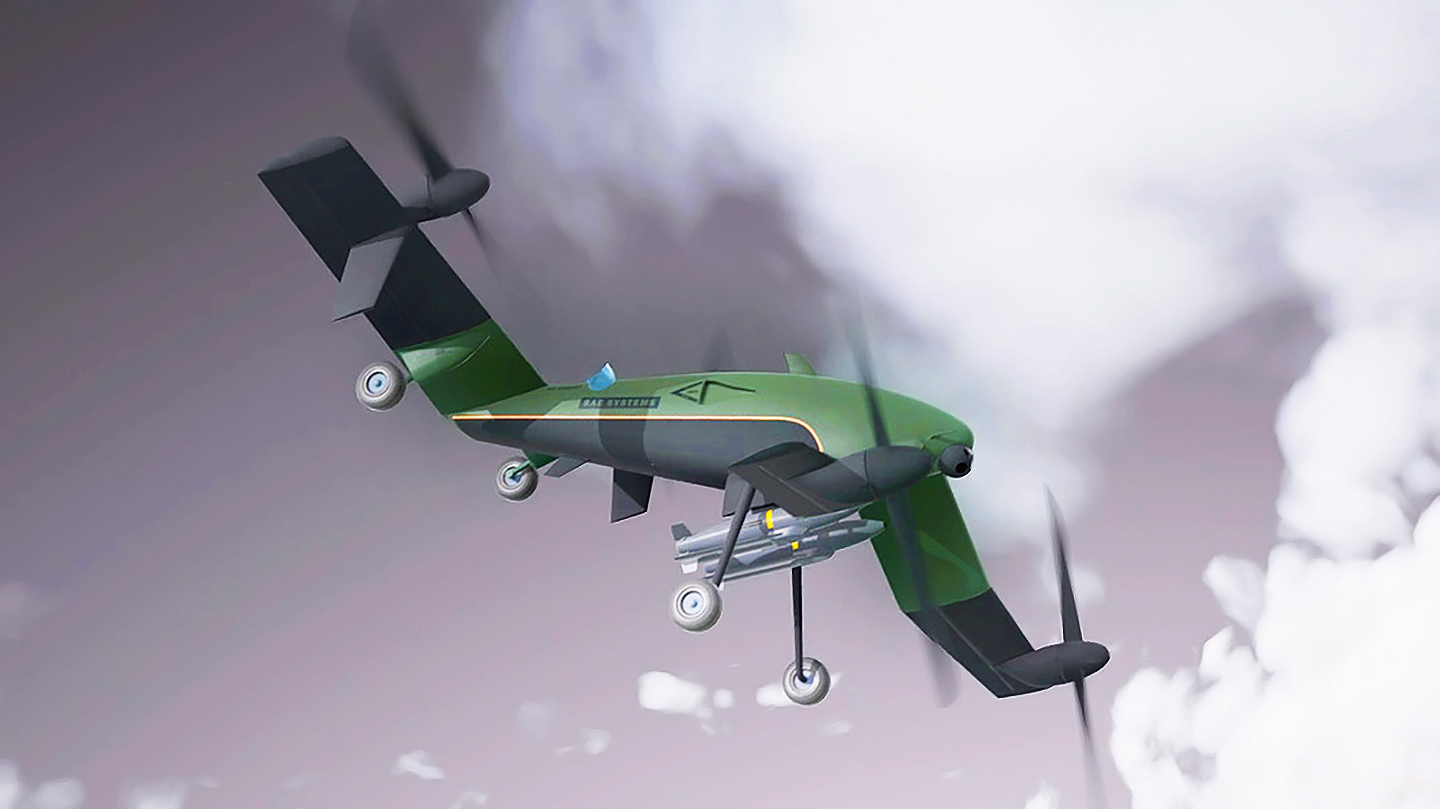BAE Systems Australia has unveiled a mock-up of the country’s first domestically designed vertical take-off and landing (VTOL) drone with both strike and intelligence-gathering capabilities, and its name is STRIX.
The STRIX mock-up was put on display Tuesday at the BAE Systems Australia booth during this year’s Avalon Airshow in Geelong, Australia, which will continue through Sunday. Joining BAE Systems Australia in STRIX’s development has been Perth-based aeronautics company Innovaero, which contributed its experience in the designing and rapid prototyping of aeronautical products for the Australian market. BAE Australia is said to have leveraged its own autonomous platform portfolio and its vehicle management system (VMS) technology, which currently guides the MQ-28 Ghost Bat drone for the Royal Australian Air Force’s autonomy program.

“STRIX leverages existing, proven technologies to provide an affordable and cost-effective capability that is mission configurable and upgradable in response to emerging technologies or threats,” said Ben Hudson, chief executive officer for BAE Australia, in the company announcement.
The War Zone contributor Roy Choo was on the ground at the Avalon Airshow and learned that STRIX was conceptualized in mid-2022. This was at about the same time that the Turkish Bayraktar TB2 had been gaining notoriety in the Ukraine conflict. Choo says that STRIX’s publicity brochures highlighted how TB2 distinguished itself by combining an inexpensive platform with the ability to strike at range. However, BAE Systems Australia says that STRIX builds on the company’s background with autonomous systems like the Taranis and Mantis uncrewed demonstrator aircraft.

According to information provided by BAE Systems Australia both at the Avalon Airshow and on the company website, STRIX, which is named after an owl species and, more famously, a demonic owl from Greek mythology, will have a collapsed footprint of 8.5 feet by 14.8 feet (2.6 meters by 4.5 meters). The UAS will be designed to offer a maximum take-off weight of about 1,985 pounds (900 kg) and carry a payload weighing up to approximately 352 pounds (160 kg) over distances of about 497 miles (800 km).
Any other technical and performance specifications do not seem to be included in the company literature available on the BAE Australia website. However, an animated promotional video does say that STRIX can hover for up to two hours and has a “flexible range.” The company has said that while work on the prototype is underway, STRIX isn’t expected to enter into an operational state until 2026.

The STRIX mock-up incorporates forward-canted wings and a V-shaped tail, each of which is equipped with a hybrid propeller engine for a total of four. It also has two sets of landing gear, with the front pair being significantly raised as the drone both takes off from and lands on its tail.
The platform’s exotic configuration is aimed at providing VTOL capabilities. BAE Systems Australia has also said that in addition to being able to launch and land vertically, STRIX transitions into a conventional horizontal flight via its tiltable body. Because of this, the UAS will offer the option of being runway independent, doing away with any need for an airstrip or catapult launching system. As such, its decreased operational footprint will expand where the UAS can operate from.
The animated BAE Australia video shows STRIX being stored and transported in a standard 20-foot shipping container before deploying from an austere location sans an airfield and really any supporting infrastructure. The video also explains that STRIX requires minimal field assembly. It is important to mention that platforms with quick deployability, a small logistics footprint, and runway independence are emerging as key capabilities for forward operations in a war in the Indo-Pacific against regional adversaries like China.

Thanks to BAE Australia’s VMS technology, STRIX “ideally will be operated as a predominantly autonomous system most of the time,” said Mic Crump, principal technologist at BAE Australia in a separate promotional video. “Take-off and landing and the transition from vertical to horizontal flight will be fully autonomous. Autonomous technologies aren’t intended to replace the human in the modern battlefield, but rather to augment them.”
Along with its high degrees of autonomy, BAE Australia specifically describes STRIX as a multi-domain and multi-role UAS. This means that the drone “could be used for a variety of missions including air-to-ground strikes against hostile targets and persistent intelligence, surveillance, and reconnaissance (ISR)” in high-risk environments. BAE Australia says that STRIX will come with target acquisition (TAR) and electronic warfare (EW) capabilities as well, rounding out a full ‘ISTAREW’ mission set that can be carried out on land, in the air, and at sea.
The renderings of STRIX as well as its mock-up show the drone with an unnamed electro-optical/infrared sensor mounted at the forward fuselage under the aircraft’s chin. A BAE Systems Australia video explains that various agnostic payload configurations will be available for the drone thanks to the modular open systems approach taken in its design, which makes it easier and more affordable to incrementally add and remove system components as needed.

In a strike role, the company says that STRIX will be able to carry and deploy a variety of air-to-ground munitions that can be found in service with the Australian Defense Force all from its two belly-mounted weapon stations. While at the Avalon Airshow, Choo learned that this will include APKWS II 70mm laser-guided rockets, as well as Hellfire and Brimstone missiles.
BAE Australia has also unveiled a brand-new locally-made missile that the company is saying was designed to complement STRIX’s capabilities. This system has been dubbed RAZER and, according to the company, “consists of a wing/body kit and tail unit equipped with a GPS/INS guidance control and navigation system, aimed at operations from uncrewed combat air vehicles and rotary wing aircraft.” The winged configuration would give STRIX more survivability when attacking targets in higher-threat areas.

“RAZER addresses a clear gap in the market for sovereign guided weapons. It will enable our Australian Defence Force ease of access to world-class munitions right here in Australia,” Hudson said. The BAE Australia website explains that the development, acquisition, and testing of RAZER will occur in the coming months but didn’t offer an expected fielding timeline.
Choo said an MBDA Sea Venom/ANL anti-ship missile could be seen on display beside the STRIX mock-up at the event as well, which speaks to the drone’s potential maritime operations. These could include performing anti-submarine warfare or mine countermeasure missions. Along with that, an additional animated BAE Australia video of STRIX in a maritime environment shows how the drone could even be configured with either sonobuoy dispensers or dipping sonar for the detection of submarines.
You can check out a BAE concept video for STRIX’s maritime applications here.
BAE Systems Australia specifically highlights how STRIX is designed to perform as a ‘loyal wingman’ for rotary-wing platforms. The ability to be operated from a helicopter would expand the mission set of both platforms while keeping human crewmembers out of harm’s way. Australia is already exploring similar concepts with its Boeing-made MQ-28 Ghost Bat drones.
STRIX pilots can fly the drone using what the company has described as an ‘easy to operate’ ground control station, with the aforementioned autonomy systems assisting in flight, navigation, and mission operations. However, any additional information about how exactly STRIX communicates with command and control seems yet to be made publicly available.

When asked by Choo, BAE Australia representatives said STRIX was not developed for any specific requirement but that they are targeting the Australian Army or Royal Australian Navy (RAN) as the platform’s first customer. While the mock-up depicts the drone with Australian Army markings, the animated maritime promotional video shows another deploying from a RAN Canberra class Landing Helicopter Dock and future Hunter class frigates.
Hudson also told Reuters that there has been strong interest from two unnamed international customers. The outlet asked if the U.S. was one of them, and he replied by saying, “What I would say is that we need a fuller business case for something like this. And I mean the U.S. market is huge.”
All told, BAE Systems Australia’s launching of STRIX could be considered a major development that has the potential to become a popular runway-independent UAS solution if it actually proves to be workable in testing. Even though that is still a ways off, VTOL drones with significant range and weapons capability are becoming more sought after overall, so STRIX’s unveiling seems well-timed.

Of course, the cost will be a huge factor. What extra cost, if any, will runway independence come at compared to other types with similar capabilities that use short airstrips? The maritime environment, where VTOL may be absolutely essential, is maybe a different story. BAE Systems Australia says that low cost is a major design driver for STRIX, so clearly they realize the value proposition is critical to overcoming the competition in an increasingly crowded medium-altitude, medium-endurance (MAME) marketplace.
Above all else, STRIX is another example of how Australia is moving forward with becoming a leading-edge weapons producer, which has the aforementioned strategic benefits, but also potential major export ones. Hudson echoed this by saying, “We’re excited that this is the first UAS of its kind to be developed in Australia and look forward to working with partners across the country to deliver this capability to customers.”
Update March 1:
We now have a better idea about the kinds of weapons that STRIX could carry, with the joint announcement from BAE Systems Australia and European missile house MBDA that the two companies will collaborate on the Guided Weapons and Explosive Ordnance (GWEO) capability for Australia.
The GWEO initiative will actually go far beyond STRIX and aims to put new and advanced guided weapons in the hands of the Australian Defense Force in general.
However, as a first step, GWEO will focus on STRIX, which also helps explain why the mock-up of the drone was displayed alongside an MBDA Sea Venom/ANL anti-ship missile. As well as this weapon, the MBDA Brimstone and SPEAR series of precision-guided munitions would appear to be obvious candidates for integration in STRIX.
At the same time, the collaboration is intended to further bilateral programs involving the United Kingdom and Australia, including the AUKUS initiative, and is also looking to secure export opportunities to regional partner nations.
BAE Systems Australia Chief Executive Officer Ben Hudson said: “BAE Systems is delighted to announce a major industrial collaboration with MBDA to establish an enhanced Guided Weapons capability in Australia. Our intent is to establish an enduring sovereign Guided Weapons capability that will leverage MBDA’s world-leading Guided Weapons portfolio and combine with BAE Systems Australia’s GWEO heritage and expertise.”
Update #2 March 1:
The Melbourne-based company AVT Australia, which specializes in multi-sensor imaging systems, has released a statement saying that its CM234 sensor gimbal system was featured on the STRIX mock-up for the concept demonstration.
According to AVT Australia, the CM234 sensor is lightweight and provides optical, infrared scanning, and laser targeting options. The statement explains that these options incorporate high-definition electro-optical, mid-wave infrared, short-wave infrared, a laser range finder, a laser target designator, and a laser pointer.
“We’re delighted to be part of the design and development of the STRIX UAS concept model at Avalon 2023,” said AVTA Managing Director Dale Heinken. “The CM234 offers a wide range of sensor capabilities and laser payloads in a small size, weight, and power.”
Contact the author: Emma@thewarzone.com
